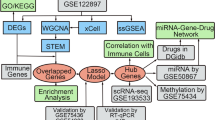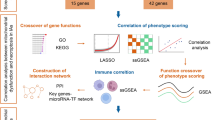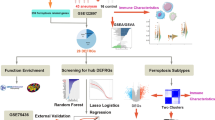Abstract
There is limited data describing endothelial cell (EC) gene expression between aneurysms and arteries partly because of risks associated with surgical tissue collection. Endovascular biopsy (EB) is a lower risk alternative to conventional surgical methods, though no such efforts have been attempted for aneurysms. We sought (1) to establish the feasibility of EB to isolate viable ECs by fluorescence-activated cell sorting (FACS), (2) to characterize the differences in gene expression by anatomic location and rupture status using single-cell qPCR, and (3) to demonstrate the utility of unsupervised clustering algorithms to identify cell subpopulations. EB was performed in 10 patients (5 ruptured, 5 non-ruptured). FACS was used to isolate the ECs and single-cell qPCR was used to quantify the expression of 48 genes. Linear mixed models and exploratory multilevel component analysis (MCA) and self-organizing maps (SOMs) were performed to identify possible subpopulations of cells. ECs were collected from all aneurysms and there were no adverse events. A total of 437 ECs was collected, 94 (22%) of which were aneurysmal cells and 319 (73%) demonstrated EC-specific gene expression. Ruptured aneurysm cells, relative controls, yielded a median p value of 0.40 with five genes (10%) with p values < 0.05. The five genes (TIE1, ENG, VEGFA, MMP2, and VWF) demonstrated uniformly reduced expression relative the remaining ECs. MCA and SOM analyses identified a population of outlying cells characterized by cell marker gene expression profiles different from endothelial cells. After removal of these cells, no cell clustering based on genetic co-expressivity was found to differentiate aneurysm cells from control cells. Endovascular sampling is a reliable method for cell collection for brain aneurysm gene analysis and may serve as a technique to further vascular molecular research. There is utility in combining mixed and clustering methods, despite no specific subpopulation identified in this trial.






Similar content being viewed by others
Abbreviations
- EB:
-
Endovascular biopsy
- FACS:
-
Fluorescence-activated cell sorting
- EC:
-
Endothelial cell
- qPCR:
-
Quantitative polymerase chain reaction
- MCA:
-
Multilevel component analysis
- SOMs:
-
Self-organizing maps
References
Backes D, Vergouwen MD, Tiel Groenestege AT, Bor AS, Velthuis BK, Greving JP, et al. PHASES score for prediction of intracranial aneurysm growth. Stroke. 2015;46(5):1221–6.
Greving JP, Wermer MJ, Brown RD, Morita A, Juvela S, Yonekura M, et al. Development of the PHASES score for prediction of risk of rupture of intracranial aneurysms: a pooled analysis of six prospective cohort studies. Lancet Neurol. 2014;13(1):59–66.
Frösen J. Smooth muscle cells and the formation, degeneration, and rupture of saccular intracranial aneurysm wall—a review of current pathophysiological knowledge. Transl Stroke Res. 2014;5(3):347–56.
Marbacher S, Marjamaa J, Bradacova K, von Gunten M, Honkanen P, Abo-Ramadan U, et al. Loss of mural cells leads to wall degeneration, aneurysm growth, and eventual rupture in a rat aneurysm model. Stroke. 2014;45(1):248–54.
Frösen J, Tulamo R, Heikura T, Sammalkorpi S, Niemelä M, Hernesniemi J, et al. Lipid accumulation, lipid oxidation, and low plasma levels of acquired antibodies against oxidized lipids associate with degeneration and rupture of the intracranial aneurysm wall. Acta Neuropathol Commun. 2013;1(1):71.
Frösen J, Tulamo R, Paetau A, Laaksamo E, Korja M, Laakso A, et al. Saccular intracranial aneurysm: pathology and mechanisms. Acta Neuropathol. 2012;123(6):773–86.
Frösen J, Marjamaa J, Myllärniemi M, Abo-Ramadan U, Tulamo R, Niemelä M, et al. Contribution of mural and bone marrow-derived neointimal cells to thrombus organization and wall remodeling in a microsurgical murine saccular aneurysm model. Neurosurgery. 2006;58(5):936–44. discussion −44
Frösen J, Piippo A, Paetau A, Kangasniemi M, Niemelä M, Hernesniemi J, et al. Growth factor receptor expression and remodeling of saccular cerebral artery aneurysm walls: implications for biological therapy preventing rupture. Neurosurgery. 2006;58(3):534–41. discussion −41
Frösen J, Piippo A, Paetau A, Kangasniemi M, Niemelä M, Hernesniemi J, et al. Remodeling of saccular cerebral artery aneurysm wall is associated with rupture: histological analysis of 24 unruptured and 42 ruptured cases. Stroke. 2004;35(10):2287–93.
Nakaoka H, Tajima A, Yoneyama T, Hosomichi K, Kasuya H, Mizutani T, et al. Gene expression profiling reveals distinct molecular signatures associated with the rupture of intracranial aneurysm. Stroke. 2014;45(8):2239–45.
Marchese E, Vignati A, Albanese A, Nucci CG, Sabatino G, Tirpakova B, et al. Comparative evaluation of genome-wide gene expression profiles in ruptured and unruptured human intracranial aneurysms. J Biol Regul Homeost Agents. 2010;24(2):185–95.
Aoki T, Kataoka H, Ishibashi R, Nozaki K, Hashimoto N. Gene expression profile of the intima and media of experimentally induced cerebral aneurysms in rats by laser-microdissection and microarray techniques. Int J Mol Med. 2008;22(5):595–603.
Yong-Zhong G, van Alphen HA. Pathogenesis and histopathology of saccular aneurysms: review of the literature. Neurol Res. 1990;12(4):249–55.
Hasan D, Hashimoto T, Kung D, Macdonald RL, Winn HR, Heistad D. Upregulation of cyclooxygenase-2 (COX-2) and microsomal prostaglandin E2 synthase-1 (mPGES-1) in wall of ruptured human cerebral aneurysms: preliminary results. Stroke. 2012.
Bygglin H, Laaksamo E, Myllärniemi M, Tulamo R, Hernesniemi J, Niemelä M, et al. Isolation, culture, and characterization of smooth muscle cells from human intracranial aneurysms. Acta Neurochir (Wien). 2011;153(2):311–8.
Jia W, Wang R, Zhao J, Liu IY, Zhang D, Wang X, et al. E-selectin expression increased in human ruptured cerebral aneurysm tissues. Can J Neurol Sci. 2011;38(6):858–62.
Pera J, Korostynski M, Krzyszkowski T, Czopek J, Slowik A, Dziedzic T, et al. Gene expression profiles in human ruptured and unruptured intracranial aneurysms: what is the role of inflammation. Stroke. 2010;41(2):224–31.
Jin D, Sheng J, Yang X, Gao B. Matrix metalloproteinases and tissue inhibitors of metalloproteinases expression in human cerebral ruptured and unruptured aneurysm. Surg Neurol. 2007;68(Suppl 2):S11–6. discussion S6
Peters D, Kassam A, Feingold E, Heidrich-O'Hare E, Yonas H, Ferrell R, et al. Molecular anatomy of an intracranial aneurysm: coordinated expression of genes involved in wound healing and tissue remodeling. Stroke. 2001;32(4):1036–42.
Feng L, Stern D, Pile-Spellman J. Human endothelium: endovascular biopsy and molecular analysis. Radiology. 1999;212(3):655–64.
Yu S, Huang L, Song Y, Li A, Qin J, Yu X, et al. Identification of human coronary artery endothelial cells obtained by coronary endovascular biopsy. Zhonghua Xin Xue Guan Bing Za Zhi. 2008;36(3):240–2.
Cooke DL, Bauer D, Sun Z, Stillson C, Nelson J, Barry D, et al. Endovascular biopsy: technical feasibility of novel endothelial cell harvesting devices assessed in a rabbit aneurysm model. Interv Neuroradiol. 2015;21(1):120–8.
Cooke DL SH, Sun Z, Guo Y, Guo D, Saeed MM, Hetts SW, Higashida RT, Dowd CF, Young WL, Halbach VV. Evaluating the feasibility of harvesting endothelial cells using detachable coils. Interv Neuroradiol. 2013.
Sun Z, Lawson DA, Sinclair E, Wang CY, Lai MD, Hetts SW, et al. Endovascular biopsy: strategy for analyzing gene expression profiles of individual endothelial cells obtained from human vessels(✩). Biotechnol Rep (Amst). 2015;7:157–65.
Sun Z, Su H, Long B, Sinclair E, Hetts SW, Higashida RT, et al. Endothelial cell high-enrichment from endovascular biopsy sample by laser capture microdissection and fluorescence activated cell sorting. J Biotechnol. 2014;192(Pt A):34–9.
Lehoux S, Tedgui A. Cellular mechanics and gene expression in blood vessels. J Biomech. 2003;36(5):631–43.
Anwar MA, Shalhoub J, Lim CS, Gohel MS, Davies AH. The effect of pressure-induced mechanical stretch on vascular wall differential gene expression. J Vasc Res. 2012;49(6):463–78.
Navone SE, Marfia G, Invernici G, Cristini S, Nava S, Balbi S, et al. Isolation and expansion of human and mouse brain microvascular endothelial cells. Nat Protoc. 2013;8(9):1680–93.
van Beijnum JR, Rousch M, Castermans K, van der Linden E, Griffioen AW. Isolation of endothelial cells from fresh tissues. Nat Protoc. 2008;3(6):1085–91.
Tirosh I, Izar B, Prakadan SM, Wadsworth MH, Treacy D, Trombetta JJ, et al. Dissecting the multicellular ecosystem of metastatic melanoma by single-cell RNA-seq. Science. 2016;352(6282):189–96.
Buettner F, Natarajan KN, Casale FP, Proserpio V, Scialdone A, Theis FJ, et al. Computational analysis of cell-to-cell heterogeneity in single-cell RNA-sequencing data reveals hidden subpopulations of cells. Nat Biotechnol. 2015;33(2):155–60.
Gaublomme JT, Yosef N, Lee Y, Gertner RS, Yang LV, Wu C, et al. Single-cell genomics unveils critical regulators of Th17 cell pathogenicity. Cell. 2015;163(6):1400–12.
Scialdone A, Natarajan KN, Saraiva LR, Proserpio V, Teichmann SA, Stegle O, et al. Computational assignment of cell-cycle stage from single-cell transcriptome data. Methods. 2015;85:54–61.
Szulwach KE, Chen P, Wang X, Wang J, Weaver LS, Gonzales ML, et al. Single-cell genetic analysis using automated microfluidics to resolve somatic mosaicism. PLoS One. 2015;10(8):e0135007.
Kumar RM, Cahan P, Shalek AK, Satija R, DaleyKeyser AJ, Li H, et al. Deconstructing transcriptional heterogeneity in pluripotent stem cells. Nature. 2014;516(7529):56–61.
Patel AP, Tirosh I, Trombetta JJ, Shalek AK, Gillespie SM, Wakimoto H, et al. Single-cell RNA-seq highlights intratumoral heterogeneity in primary glioblastoma. Science. 2014;344(6190):1396–401.
Shalek AK, Satija R, Adiconis X, Gertner RS, Gaublomme JT, Raychowdhury R, et al. Single-cell transcriptomics reveals bimodality in expression and splicing in immune cells. Nature. 2013;498(7453):236–40.
Liquet B, Lê Cao KA, Hocini H, Thiébaut R. A novel approach for biomarker selection and the integration of repeated measures experiments from two assays. BMC Bioinf. 2012;13:325.
Westerhuis JA, van Velzen EJ, Hoefsloot HC, Smilde AK. Multivariate paired data analysis: multilevel PLSDA versus OPLSDA. Metabolomics. 2010;6(1):119–28.
Team RC. R: a language and environment for statistical computing. R Foundation for Statistical Computing; 2016.
Liquet K-ALCFRGDBGBPMCZY. mixOmics: omics. Data integration project. R package version 6.1.2. ed: https://CRAN.R-project.org/package=mixOmics (2017).
Shekhar K, Lapan SW, Whitney IE, Tran NM, Macosko EZ, Kowalczyk M, et al. Comprehensive classification of retinal bipolar neurons by single-cell transcriptomics. Cell. 2016;166(5):1308–23.e30.
Macosko EZ, Basu A, Satija R, Nemesh J, Shekhar K, Goldman M, et al. Highly parallel genome-wide expression profiling of individual cells using nanoliter droplets. Cell. 2015;161(5):1202–14.
Satija R, Farrell JA, Gennert D, Schier AF, Regev A. Spatial reconstruction of single-cell gene expression data. Nat Biotechnol. 2015;33(5):495–502.
Adiconis X, Borges-Rivera D, Satija R, DeLuca DS, Busby MA, Berlin AM, et al. Comparative analysis of RNA sequencing methods for degraded or low-input samples. Nat Methods. 2013;10(7):623–9.
Saarinen J, Kohonen T. Self-organized formation of colour maps in a model cortex. Perception. 1985;14(6):711–9.
Kohonen T. Adaptive, associative, and self-organizing functions in neural computing. Appl Opt. 1987;26(23):4910–8.
Kohonen T. Self-organized formation of topologically correct feature maps. Biol Cybern. 1982;43:59–69.
Datta S. Comparisons and validation of statistical clustering techniques for microarray gene expression data. Bioinformatics. 2003;19(4):459–66.
Datta S. Methods for evaluating clustering algorithms for gene expression data using a reference set of functional classes. BMC Bioinf. 2006;7:397.
Brock G, Pihur V, Datta S, Datta S. clValid: an R package for cluster validation. J Stat Softw. 25(4) http://www.jstatsoft.org/v25/i04 ed2008.
Handl J, Knowles J, Kell DB. Computational cluster validation in post-genomic data analysis. Bioinformatics. 2005;21(15):3201–12.
Kim TG, Kim NK, Baek MJ, Huh R, Chung SS, Choi JU, et al. The relationships between endothelial nitric oxide synthase polymorphisms and the formation of intracranial aneurysms in the Korean population. Neurosurg Focus. 2011;30(6):E23.
Foroud T, Sauerbeck L, Brown R, Anderson C, Woo D, Kleindorfer D, et al. Genome screen in familial intracranial aneurysm. BMC Med Genet. 2009;10:3.
Foroud T, Sauerbeck L, Brown R, Anderson C, Woo D, Kleindorfer D, et al. Genome screen to detect linkage to intracranial aneurysm susceptibility genes: the Familial Intracranial Aneurysm (FIA) study. Stroke. 2008;39(5):1434–40.
Krischek B, Inoue I. The genetics of intracranial aneurysms. J Hum Genet. 2006;51(7):587–94.
Acknowledgements
The authors would like to thank the UCSF Neurointerventional Radiology service, particularly its fellows, for their help in the sample collection.
Sources of Funding
The project was funded in part by the Society for Neurointerventional Surgery, the UCSF Department of Radiology, and by a grant from the National Cancer Institute R01 CA056721 to Z.W.
Author information
Authors and Affiliations
Corresponding author
Ethics declarations
Conflict of Interest
The authors declare that they have no conflict of interest.
Ethical Approval
All procedures performed in studies involving human participants were in accordance with the ethical standards of the institutional and/or national research committee and with the 1964 Helsinki Declaration and its later amendments or comparable ethical standards.
Rights and permissions
About this article
Cite this article
Cooke, D.L., McCoy, D.B., Halbach, V.V. et al. Endovascular Biopsy: In Vivo Cerebral Aneurysm Endothelial Cell Sampling and Gene Expression Analysis. Transl. Stroke Res. 9, 20–33 (2018). https://doi.org/10.1007/s12975-017-0560-4
Received:
Revised:
Accepted:
Published:
Issue Date:
DOI: https://doi.org/10.1007/s12975-017-0560-4




